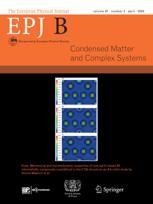A novel computing approach to recognising chaos
Chaos isn’t always harmful to technology, in fact, it can have several useful applications if it can be detected and identified.
New York | Heidelberg, 14 April 2022

Chaos and its chaotic dynamics are prevalent throughout nature and through manufactured devices and technology. Though chaos is usually considered a negative, something to be removed from systems to ensure their optimal operation, there are circumstances in which chaos can be a benefit and can even have important applications. Hence a growing interest in the detection and classification of chaos in systems.
A new paper published in EPJ B authored by Dagobert Wenkack Liedji and Jimmi Hervé Talla Mbé of the Research unit of Condensed Matter, Electronics and Signal Processing, Department of Physics, University of Dschang, Cameroon, and Godpromesse Kenné, from Laboratoire d’ Automatique et d’Informatique Appliquée, Department of Electrical Engineering, IUT-FV Bandjoun, University of Dschang, Cameroon, proposes using the single nonlinear node delay-based reservoir computer to identify chaotic dynamics.
In the paper, the authors show that the classification capabilities of this system are robust with an accuracy of over 99 per cent. Examining the effect of the length of the time series on the performance of the method they found higher accuracy achieved when the single nonlinear node delay-based reservoir computer was used with short time series.
Several quantifiers have been developed to distinguish chaotic dynamics in the past, prominently the largest Lyapunov exponent (LLE), which is highly reliable and helps display numerical values that help to decide on the dynamical state of the system.
The team overcame issues with the LLE like expense, need for the mathematical modelling of the system, and long-processing times by studying several deep learning models finding these models obtained poor classification rates. The exception to this was a large kernel size convolutional neural network (LKCNN) which could classify chaotic and nonchaotic time series with high accuracy.
Thus, using the Mackey-Glass (MG) delay-based reservoir computer system to classify nonchaotic and chaotic dynamical behaviours, the authors showed the ability of the system to act as an efficient and robust quantifier for classifying non-chaotic and chaotic signals.
They listed the advantages of the system they used as not necessarily requiring the knowledge of the set of equations, instead, describing the dynamics of a system but only data from the system, and the fact that neuromorphic implementation using an analogue reservoir computer enables the real-time detection of dynamical behaviours from a given oscillator.
The team concludes that future research will be devoted to deep reservoir computers to explore their performances in classifications of more complex dynamics.
References: Liedji, D.W., Talla Mbé, J.H. & Kenné, G. Chaos recognition using a single nonlinear node delay-based reservoir computer., Eur. Phys. J. B 95:18, https://doi.org/10.1140/epjb/s10051-022-00280-6
Further Information
For more information visit: www.epj.org
Services for Journalists
The full-text article is available here.
Contact
Sabine Lehr | Springer | Physics Editorial Department
tel +49-6221-487-8336 | sabine.lehr@springer.com
